The Story of our Flock
My husband and I had not been married a year when we purchased a beautiful home on the Poca River here in West Virginia. With it came two acres of land and a wild chicken. She was kept by the previous owners but when her rooster was killed by one of their dogs, she ran off into the woods to live on her own. In the first couple months we were living there, I'd see her occasionally around the wild bird feeders. Roger, my husband, put out cracked corn for her. Then he decided she was lonely.

Penny Pen the Wild Chicken
One of my colleagues had moved from Kentucky where he had over a hundred acres and 15 chickens, none of which he was planning to bring with him. He donated two birds to our cause.

Gertie Girl and Myrtle
All was well with the two new birds. Gert and Myrt roamed the land and came home every evening at dusk. Penny was no where to be found until one day when she met up with Gertie by the side of the house and that's when the fun began.

Penny Pen meets Gertie Girl (chicken mama almost drops camera when fight starts).
I was convinced that Penny Pen would never come back to domestication and hoped that she wouldn't go after the girls again. She fought with Myrtle later that day, and I guess Myrtle showed her a thing or two, because Penny ran off into the woods again.
Things were peaceful on the shores of the Poca River for about a month until Roger decided that if something happened to one of the girls, the other would be lonely. Meanwhile, we had been enjoying delicious farm-fresh eggs, one green one from Myrtle, who by this time I had identified as an Ameraucana, and a brown egg from Gertie whom I have never been able to identify. (I think she's a mutt, but she's very loveable and will squat for pets and scratches.)
So, I went online to see if I could find someone in the area (this IS West Virginia, afterall) who was selling laying hens. Low and behold, right down the street was BYC member, FayKokoWV. We visited her flock and came home with Martha, Mabel and Bertie Bird.

Martha, the Barred Plymouth Rock, Bertie Bird, the Black Jersey Giant and Mabel, the Red Star
As you can see from the picture, they have the run of the place. Our porch has now been christened "The Poop Deck" and I just sweep and spray off the area whenever the bipeds need to use it.
With the additional three, we were at five and the October breezes started blowing. The evenings were getting pretty chilly. And just like nuclear fission, somehow we must have achieved chicken "critical mass" because Penny Pen started hanging around with the girls. The three new birds accepted her readily (Penny never squared off with them!) but Myrt and Gert would give Penny a wide berth. Penny took to coming into the hen house for a bite to eat during the day, but when evening came, she was up in her roosting tree in the woods (Roger followed her one evening to see where she went).
The weather got colder. And one night, as I was checking on the girls and locking up the house, I heard some rustling in the eaves of the shed/chicken coop. There was Penny, staring down at me. I locked up all six birds and Penny never left the flock.
The winter came and Roger ran an electrical cord out to the hen house and purchased a heated water bowl. We hung a heat lamp to keep the shed warmer in the freezing nights and we stuffed insulation into the eaves of the shed to keep the wind out. The birds seemed happy and were laying at about 75%. With six birds, we were getting about almost three dozen eggs a week.
Roger kept talking about wanting more chickens. He'd torment me by mentioning in passing that soon we'd have 24 birds. I'd counter with, "no more than five more!" An arbitrary sum, indeed. Finally he could stand it no more. "Let's go see our neighbor and see if she's willing to sell us more birds!" She was.

Two Fayoumis, two Andalusians and a Buff Minorca.
With eleven birds, you'd think we'd stop for a while. Nope. Now he talked about raising chicks. We at first didn't want to raise chicks because of these little guys:

Tommy Cat

Trixie Ann
They look like fierce beasts, don't they? Both Tommy Cat and Trixie Ann were "schooled" by the hens to not prey on them (I never saw Tommy Cat jump as high as when Myrtle ran up the hill and pecked him in the side one day!) but little chicks are a different story.
We figured out how to make a cage that would work to raise chicks, but it wasn't particularly "cat-proof:"

Roger sets up the chick cage
and we ordered the chicks, thinking we'd just keep the cage in the spare bedroom where it would be warm, and where we could easily set up a heat lamp to keep it really warm.
We ordered our chicks from www.mypetchicken.com, and they sent us an email saying our chicks would be hatched on a certain day. Roger called the Post Office to warn them that we were expecting chicks and left them our phone number to call as soon as the chicks arrived. That worked out very well. They called at 9:30 and by noon, Roger had the chicks in the cage. Now we had nine more birds for a total of twenty. Of course, you can't count your chicks right away.

Nine baby chicks
We had the chicks immunized against Coccidiosis and in the first couple of days we watched for "pasty butt." I treated three of the birds for this. They seemed to have large mats of droppings on their behinds. A warm wet cloth helped soak off the droppings and then I smeared a little vaseline on their vents to prevent further sticking. They didn't like the process much and still have an aversion to seeing me when I come to check on them. I haven't tried handling them again. When they are a little older, I might try again to get them used to human contact.
Another issue was the fact that the bars of the cage are too far apart for chicks. Early on, while I was in watching them, one of the Plymouth Rocks came up to the bars and wiggled her wings through the opening and "popped" out of the cage. I picked her up and let her walk back into the cage. I went down to the living room and announced to Roger that we'd need to do something to the cage. Later that evening, he came up and three chicks were out of the cage. He took hardware cloth (the same as we used on the floor) and wrapped the cage. No more AWOL chicks.
It's been a week, and the chicks are thriving. The older girls are grateful for the warm weather and on sunny days they range far and wide looking for bugs and fresh shoots to eat. My hope is that we can stay at 20 birds for the rest of the year, but with Roger, you never know! I am so thankful that he's not interested in other livestock and is not talking about keeping dairy cattle!

Our chicks at one week old. Three Red Stars, Two barred Plymouth Rocks and four Rhode Island Reds.
My husband and I had not been married a year when we purchased a beautiful home on the Poca River here in West Virginia. With it came two acres of land and a wild chicken. She was kept by the previous owners but when her rooster was killed by one of their dogs, she ran off into the woods to live on her own. In the first couple months we were living there, I'd see her occasionally around the wild bird feeders. Roger, my husband, put out cracked corn for her. Then he decided she was lonely.
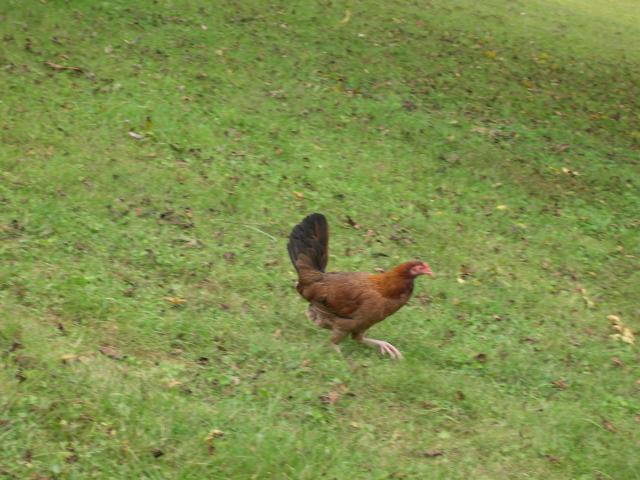
Penny Pen the Wild Chicken
One of my colleagues had moved from Kentucky where he had over a hundred acres and 15 chickens, none of which he was planning to bring with him. He donated two birds to our cause.
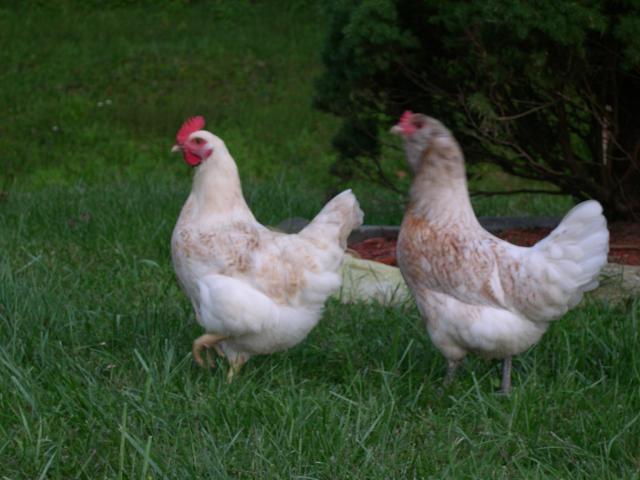
Gertie Girl and Myrtle
All was well with the two new birds. Gert and Myrt roamed the land and came home every evening at dusk. Penny was no where to be found until one day when she met up with Gertie by the side of the house and that's when the fun began.
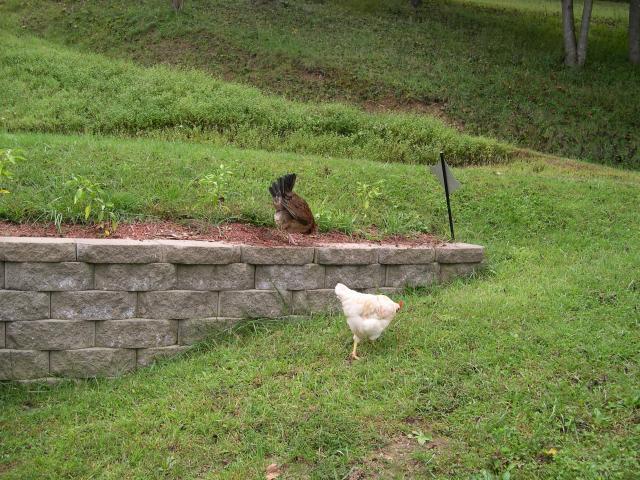
Penny Pen meets Gertie Girl (chicken mama almost drops camera when fight starts).
I was convinced that Penny Pen would never come back to domestication and hoped that she wouldn't go after the girls again. She fought with Myrtle later that day, and I guess Myrtle showed her a thing or two, because Penny ran off into the woods again.
Things were peaceful on the shores of the Poca River for about a month until Roger decided that if something happened to one of the girls, the other would be lonely. Meanwhile, we had been enjoying delicious farm-fresh eggs, one green one from Myrtle, who by this time I had identified as an Ameraucana, and a brown egg from Gertie whom I have never been able to identify. (I think she's a mutt, but she's very loveable and will squat for pets and scratches.)
So, I went online to see if I could find someone in the area (this IS West Virginia, afterall) who was selling laying hens. Low and behold, right down the street was BYC member, FayKokoWV. We visited her flock and came home with Martha, Mabel and Bertie Bird.
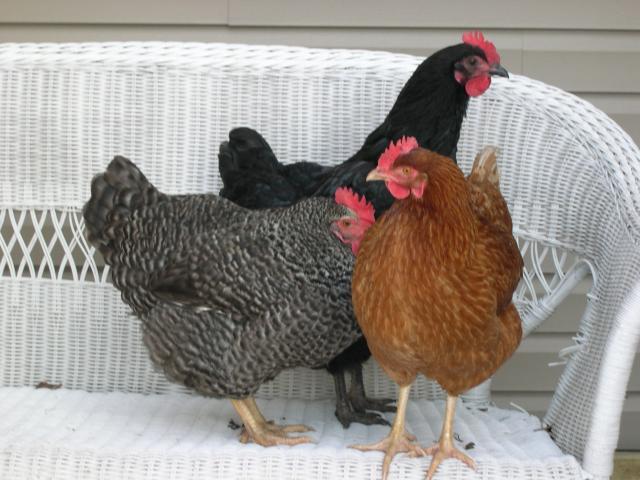
Martha, the Barred Plymouth Rock, Bertie Bird, the Black Jersey Giant and Mabel, the Red Star
As you can see from the picture, they have the run of the place. Our porch has now been christened "The Poop Deck" and I just sweep and spray off the area whenever the bipeds need to use it.
With the additional three, we were at five and the October breezes started blowing. The evenings were getting pretty chilly. And just like nuclear fission, somehow we must have achieved chicken "critical mass" because Penny Pen started hanging around with the girls. The three new birds accepted her readily (Penny never squared off with them!) but Myrt and Gert would give Penny a wide berth. Penny took to coming into the hen house for a bite to eat during the day, but when evening came, she was up in her roosting tree in the woods (Roger followed her one evening to see where she went).
The weather got colder. And one night, as I was checking on the girls and locking up the house, I heard some rustling in the eaves of the shed/chicken coop. There was Penny, staring down at me. I locked up all six birds and Penny never left the flock.
The winter came and Roger ran an electrical cord out to the hen house and purchased a heated water bowl. We hung a heat lamp to keep the shed warmer in the freezing nights and we stuffed insulation into the eaves of the shed to keep the wind out. The birds seemed happy and were laying at about 75%. With six birds, we were getting about almost three dozen eggs a week.
Roger kept talking about wanting more chickens. He'd torment me by mentioning in passing that soon we'd have 24 birds. I'd counter with, "no more than five more!" An arbitrary sum, indeed. Finally he could stand it no more. "Let's go see our neighbor and see if she's willing to sell us more birds!" She was.
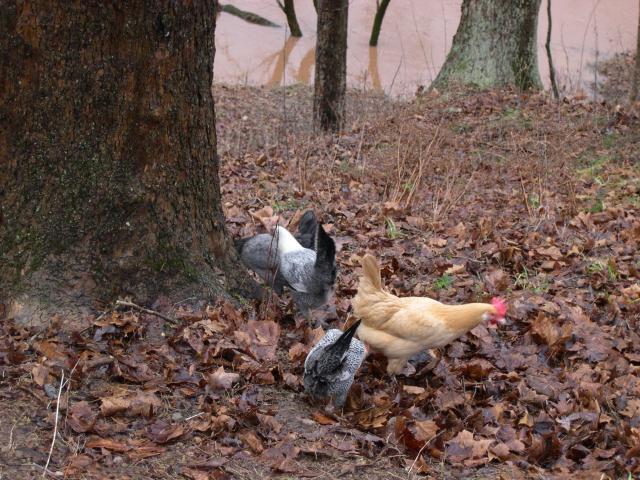
Two Fayoumis, two Andalusians and a Buff Minorca.
With eleven birds, you'd think we'd stop for a while. Nope. Now he talked about raising chicks. We at first didn't want to raise chicks because of these little guys:
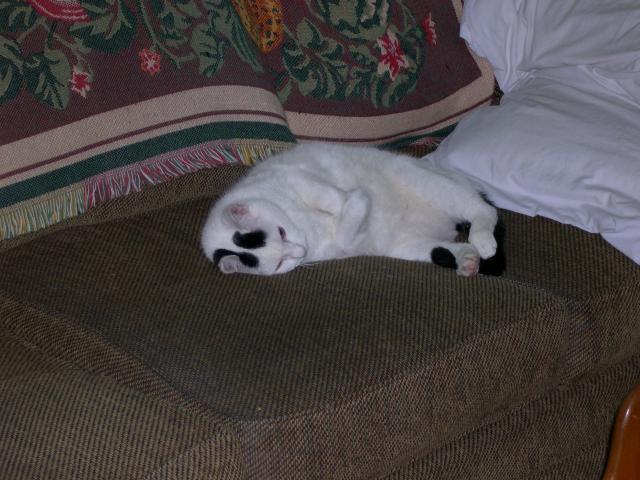
Tommy Cat
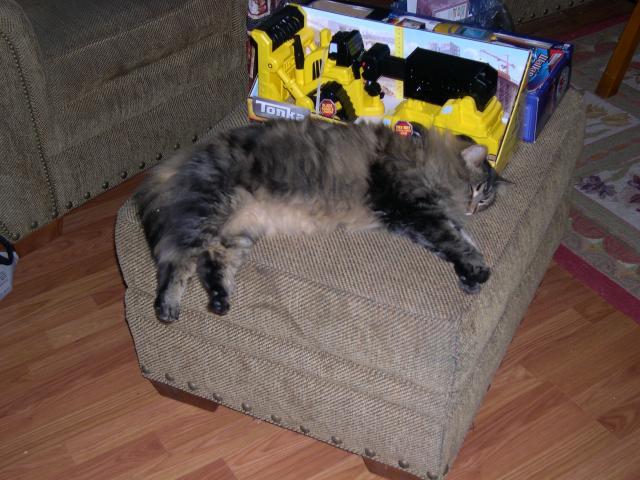
Trixie Ann
They look like fierce beasts, don't they? Both Tommy Cat and Trixie Ann were "schooled" by the hens to not prey on them (I never saw Tommy Cat jump as high as when Myrtle ran up the hill and pecked him in the side one day!) but little chicks are a different story.
We figured out how to make a cage that would work to raise chicks, but it wasn't particularly "cat-proof:"
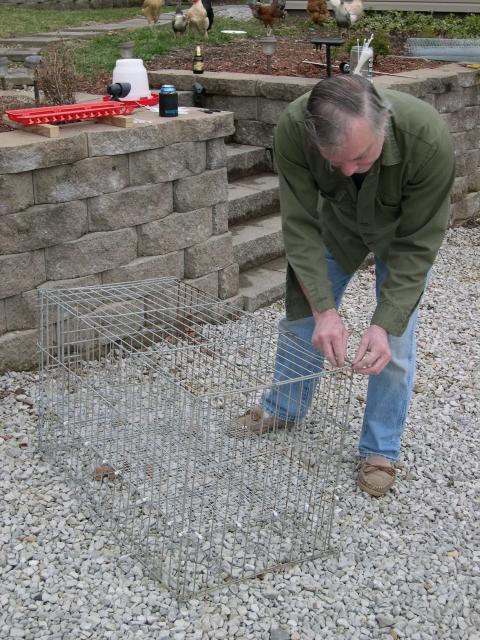
Roger sets up the chick cage
and we ordered the chicks, thinking we'd just keep the cage in the spare bedroom where it would be warm, and where we could easily set up a heat lamp to keep it really warm.
We ordered our chicks from www.mypetchicken.com, and they sent us an email saying our chicks would be hatched on a certain day. Roger called the Post Office to warn them that we were expecting chicks and left them our phone number to call as soon as the chicks arrived. That worked out very well. They called at 9:30 and by noon, Roger had the chicks in the cage. Now we had nine more birds for a total of twenty. Of course, you can't count your chicks right away.
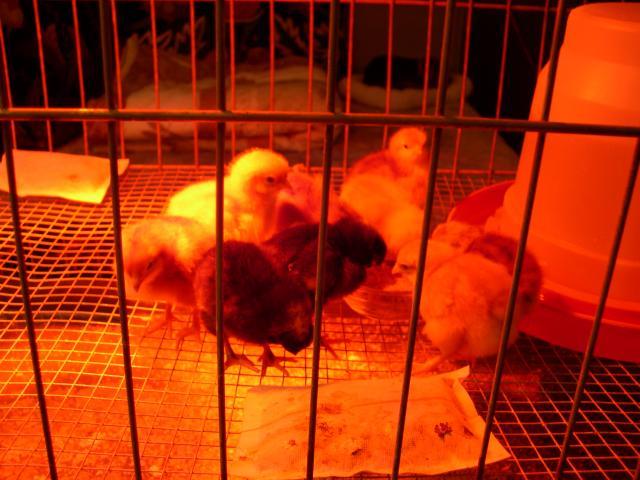
Nine baby chicks
We had the chicks immunized against Coccidiosis and in the first couple of days we watched for "pasty butt." I treated three of the birds for this. They seemed to have large mats of droppings on their behinds. A warm wet cloth helped soak off the droppings and then I smeared a little vaseline on their vents to prevent further sticking. They didn't like the process much and still have an aversion to seeing me when I come to check on them. I haven't tried handling them again. When they are a little older, I might try again to get them used to human contact.
Another issue was the fact that the bars of the cage are too far apart for chicks. Early on, while I was in watching them, one of the Plymouth Rocks came up to the bars and wiggled her wings through the opening and "popped" out of the cage. I picked her up and let her walk back into the cage. I went down to the living room and announced to Roger that we'd need to do something to the cage. Later that evening, he came up and three chicks were out of the cage. He took hardware cloth (the same as we used on the floor) and wrapped the cage. No more AWOL chicks.
It's been a week, and the chicks are thriving. The older girls are grateful for the warm weather and on sunny days they range far and wide looking for bugs and fresh shoots to eat. My hope is that we can stay at 20 birds for the rest of the year, but with Roger, you never know! I am so thankful that he's not interested in other livestock and is not talking about keeping dairy cattle!
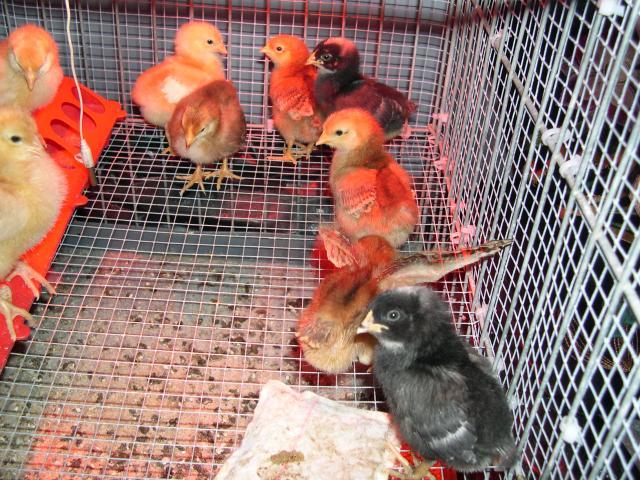
Our chicks at one week old. Three Red Stars, Two barred Plymouth Rocks and four Rhode Island Reds.
